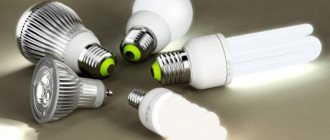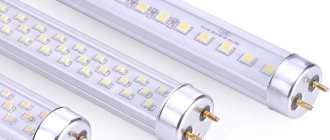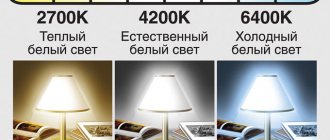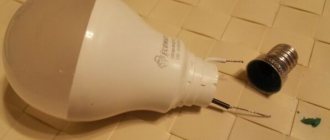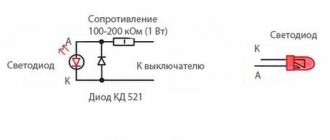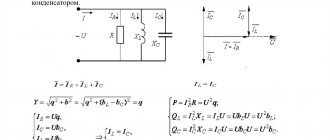Dimmer is a device for adjusting the brightness of lighting fixtures in a room. Mainly used to change brightness depending on the required lighting and also to reduce power consumption. The process of adjusting brightness is called dimming. Simply purchasing a regulator and installing it will not work, since not all lighting devices support such equipment. Below we will consider which light bulbs are suitable for a dimmer, how to choose the device itself and connect it to the existing electrical network in the apartment.
It is impossible to control the dimming level in fluorescent lighting sources, and adjustments are not available in some models of LED light bulbs. There will be no problems with operation when using conventional incandescent lamps.
You can understand whether your light bulb is suitable for dimming simply by reading the packaging - the vast majority of manufacturers indicate this information when labeling.
Difficulties when connecting a dimmer are also possible if the lighting fixtures in a house or apartment are equipped with additional elements - transformers, drivers for operation, etc.
Features of work
A device is a device that allows you to regulate the current power of a light bulb. In Russia, most electrical networks operate according to the 220 V AC standard. These data indicate that the voltage in the network constantly changes its polarity and returns to zero within a few fractions of a second. The presence of a dimmer in the electrical network will allow you to regulate at what point the light bulb should light up during the passage of a sine wave. The process of changing power in a luminaire can be called “phase control”.
The device can be installed instead of a regular switch, and it will not only allow you to turn the lighting on and off in a specific room, but also adjust its brightness. There are other dimmers in the field of electrical equipment. To make it easier to understand the principle of working with a light bulb, just imagine a vacuum cleaner - in it the rotary handle acts as a kind of dimmer.
Using a dimmer in the electrical network is an opportunity to create comfortable lighting in a room, regardless of the current light level. Installation in the electrical network is a guarantee that the lamp will last a long time and without failures.
The light bulbs used in the system must be suitable for dimming, and it is also important to ensure that junction boxes, transformers and other equipment in the network support the regulator.
Installation of switches
In terms of dimensions, the dimmer switch resembles a standard device for turning lights on and off. Installation of the dimmer is carried out using special claws in the break of the lighting chain. The main requirement for the installer is to observe polarity.
The figure below shows the dimmer connection diagram.
You can learn how to connect two dimmers from the following diagram.
If you are going to install a dimmer instead of a switch, you will first need to dismantle the old model. But even before this, you should turn off the power supply and check the absence of voltage using an indicator. To remove the old switch, take a screwdriver and unscrew the screws of the mounting tabs. After this, remove the device panel. Then loosen the screws on the terminals and disconnect the switch from the wires.
The next step is installing a dimmer. Installation is carried out in the reverse order to that described above for dismantling. After installing the dimmer in the socket box, fix it with screws and install a decorative frame. If it is necessary to adjust the lighting in several places, you will need additional dimmers and installation of socket boxes with cable laying to them.
Source
How to choose an LED lamp
If it is not difficult to decide which lamps are suitable for a dimmer when it comes to ordinary retro incandescent lamps, then some difficulties may arise with the selection of a dimmable LED lamp. Consider a number of nuances when choosing a suitable lamp:
- Carefully study the packaging of the LED lamp you are purchasing. Most manufacturers put corresponding markings or a special symbol on the packaging. If there is no marking, then you have an ordinary retro lamp that does not support dimming adjustment; it cannot be used with a dimmer;
- If you bought a device for conventional incandescent lamps, a new LED light bulb with it will most likely not work. You need to purchase a special regulator, which is designed specifically for LED lamps;
- If, when connecting an LED light bulb to a conventional incandescent lamp device, you encounter uncharacteristic operation - the lamp makes a strange noise, crackling, the lamp goes out on its own - it is advisable to stop the experiment. If the equipment does not work properly with each other, the dimmer, the light bulb, the retro switches, as well as other electronics in the apartment will fail due to a possible short circuit;
- Do not use special LED retro lamps marked “Smart”. The equipment already has its own electronics built inside to dim the light level depending on external conditions or current manual settings. As a result, the lamp will constantly come into conflict with the external dimmer.
Selecting a dimmer for LED light bulbs
In order to use a dimmer to adjust the brightness of an LED lamp, you must first know whether its design allows dimming. Therefore, first of all, carefully study all the symbols on the lamp packaging. If you need to use a 220V light bulb, then you need to choose a phase-pulse light source that has a cutoff at the trailing edge.
When choosing a lamp for a low-voltage circuit, you need to install a PWM dimmer. Special regulators are used with LED strips. Manufacturers also produce low-voltage dimmers for 12V spotlights.
What problems can you encounter when using a dimmer?
Stable operation of the dimmer is guaranteed only with old incandescent lamps, since the brightness of the light in them directly depends on the power of the supplied current. Simply turn the knob in the desired direction to increase or decrease the brightness of the glow. Using the regulator with incandescent lamps should not cause any difficulties.
Problems arise when connecting an LED light bulb to the same circuit as a dimmer. Most often, users encounter the following problems:
- the presence of a dimmer in the network leads to the fact that the lamp does not light up at all;
- the device turns on, but is constantly lit at maximum brightness, regardless of the settings;
- during operation, a strong hum and uncharacteristic crackling noise is heard;
- An unpleasant flickering of light appears when the switch is set to a certain position or in constant dimming mode.
Sometimes the LED light will work fine right after connecting, but then it will start to turn off when you try to dim the current brightness level. Most often, problems arise if the user tries to set the voltage below the minimum required to power the device.
You should not use conventional dimmers with LED retro lamps - such a connection will most likely cause failure of the lamp, the light bulb and the dimmer itself.
For LED lamps, there are special regulators on sale, in which the brightness is increased and decreased by changing the width of the pulses of direct current passing through the LEDs. Many people do not buy a dimmer just because they are confident that the lamp will flicker during operation. Flickers are indeed possible, but they are not perceived by the human eye.
LED bulbs 12V
The operating principle of DC electrical circuits is completely different from that of AC lines. Therefore, special 12V dimmers are used. They differ in the so-called dosing component. In a 12V circuit, this is a transistor. It can be field or bipolar type. In this case, the dispenser is a pulse generator. This element has a modified fill factor.
Dimmer for diode strip Source led-labs.eu
Dimming of 12V LED lamps is performed using pulse width modulation. This method is used to regulate LED strips. If the pulse duration increases and the pause decreases, then the output voltage from the dimmer increases.
The signals in the pulse width modulation dimming circuit are inherently symmetrical. This means that the pause between pulses is equal to their length. Due to the presence of a potentiometer and 2 diodes in the circuit, the capacitive element is charged and recharged. These processes occur through different contact pairs of the potentiometer. As a result, pulses are formed that have a constant frequency. Moreover, they have a variable fill factor.
Kinds
All dimmers available for purchase for LED and other lighting can be schematically divided into several types:
- Mechanical;
- Electronic contact;
- Electronic contactless.
In the first case, you can dim the lamp by simply turning the mechanical knob in the desired direction. There are also combined dimmers, in which the user has several control methods available at once.
A suitable regulator option for vintage wiring is a dimmer with a rotary mechanism. In some cases, the device is additionally equipped with a control panel and allows you to change settings not only by turning the knob, but also remotely. The principle of operation is simple - just rotate left and right to select the appropriate level of lighting intensity at the moment. If you use a remote control for adjustment, make sure that its beam is directed directly at the regulator body, and the distance between the devices does not exceed 5 meters, otherwise there will be no operation.
Range of control devices
Dimmers are quite widely represented on the lighting market today. All their diversity can be divided into the following groups:
- modular. They are placed on DIN rails in distribution panels. They are used very widely. Such devices can be used to adjust the brightness of lighting, create lighting effects, and also as part of the Smart Home system. The control mechanism here is carried out through remote controls and buttons. The regulator is located in the installation box. It can be installed instead of a switch. Such a device is controlled using a switch or buttons;
Modular dimmer
- monoblock devices. They can also be mounted in a mounting box. It is the most common type of device of this kind. Such a dimmer is installed and connected in the same way as a simple switch - into a phase wire break;
Monoblock regulator
- remote blocks. Used to connect spotlights equipped with LED bulbs. They are controlled by radio or infrared remote controls, as well as remote panels and conventional dimmers.
Remote block
Also, dimmers, according to the control method, have the following classification:
- rotary. In this situation, a rotary knob is used that rotates clockwise and counterclockwise;
- rotary-push. To turn on the device, you need to press the knob, and the control process itself is carried out by a standard turn of the knob;
Note! With rotary-push dimmers, you can turn off the load by placing the control in a certain position.
- push-button (keyboard). There are keys on the front panel that can be used to decrease or increase brightness;
- sensory. These are the most modern models. Control here is carried out by touching the touch panel.
You can use any type of dimmer in your home.
Installation Features
The regulator is installed in the same way as the rotary switch, using an identical mounting box in the process. If you need to install a regulator for a specific chandelier or lamp in a room, you can remove the old retro switch and install a dimmer in its place. The last option is the simplest - you do not need to lay any additional wiring to the installation site.
If a dimmer is inserted instead of a retro switch, a phase break is carried out during installation, a wire from an electric meter is connected to the input terminal, and a wire from an LED or incandescent lamp is connected to the output terminal. It is important to carefully monitor the location of the “Input” and “Output” terminals to avoid errors in the process. If you do not have experience connecting electrical appliances, it is advisable to involve a specialist in the process to prevent electric shock.
A correctly selected dimmer will allow you to achieve the optimal level of lighting in the room under various operating conditions of lighting fixtures. In order to avoid breakdowns during operation or emergency situations as a result of network overload, it is advisable to consult with store employees before purchasing.
Connecting the dimmer
There are several dimmer connection schemes.
Dimmer circuit with switch
In the described case, the dimmer is installed in front of the dimmer in a phase gap. The switch controls the flow of current. The connection diagram is shown in the figure below.
From the switch, the current is directed to the dimmer, and from there to the incandescent light bulb. As a result, the regulator determines the desired brightness level, and the switch is responsible for turning the chain on and off.
The scheme is well suited for bedrooms. The switch is placed near the door, and the dimmer is located near the bed. This makes it possible to control the light directly from the bed. When a person leaves the room, the light goes out, and when a person returns to the room, the light lights up with the characteristics that were set by the dimmer.
Connection diagram with two dimmers
This circuit contains two soft light switches. They are mounted in two places in one room and are essentially pass-through switches that control individual lighting fixtures.
The circuit involves connecting three conductors to the junction box from each point. To connect dimmers, connect the first and second contacts in the dimmers with jumpers. Then the phase that goes to the lighting device through the third contact of the second dimmer is supplied to the third contact of the first dimmer.
Circuit with two pass-through switches
This scheme is used quite rarely. It is in demand for organizing lighting control in walk-through rooms and long corridors. The circuit allows you to turn the light on and off, as well as adjust it from different ends of the room.
Pass-through switches are placed in a phase gap. The contacts are connected by conductors. The dimmer enters the chain in a sequential manner, after one of the switches. A phase approaches the first contact, which then goes to the incandescent lamp.
Brightness control is carried out by a dimmer. However, it should be borne in mind that when the regulator is turned off, the pass-through switches are not capable of switching light bulbs.


